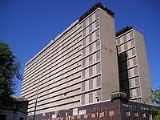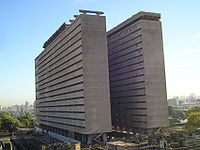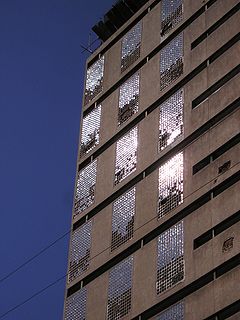
Caseros Prison
Encyclopedia


Panopticon
The Panopticon is a type of building designed by English philosopher and social theorist Jeremy Bentham in the late eighteenth century. The concept of the design is to allow an observer to observe all inmates of an institution without them being able to tell whether or not they are being watched...
prison in Parque Patricios
Parque Patricios
Parque Patricios is a barrio located on the southern side of Buenos Aires, Argentina belonging to the fourth comuna.Parque Patricios underwent a transformation during the beginning of the 1900's...
, a neighborhood in the southern part of Buenos Aires
Buenos Aires
Buenos Aires is the capital and largest city of Argentina, and the second-largest metropolitan area in South America, after São Paulo. It is located on the western shore of the estuary of the Río de la Plata, on the southeastern coast of the South American continent...
, Argentina
Argentina
Argentina , officially the Argentine Republic , is the second largest country in South America by land area, after Brazil. It is constituted as a federation of 23 provinces and an autonomous city, Buenos Aires...
.
Caseros Prison was conceived by the military dictatorships of the 1960s, originally intended as a short term holding station for prisoners awaiting trial. It was built over the course of almost twenty years, from 1960 until 1979. Finished under the administration of the military junta presided over by dictator Jorge Rafael Videla
Jorge Rafael Videla
Jorge Rafael Videla Redondo is a former senior commander in the Argentine Army who was the de facto President of Argentina from 1976 to 1981. He came to power in a coup d'état that deposed Isabel Martínez de Perón...
, Caseros was opened in 1979 to house political prisoners. It was built next to an old prison of the same name, which was originally constructed as an orphanage in the 1880s. In the early 1950s, Juan Perón
Juan Perón
Juan Domingo Perón was an Argentine military officer, and politician. Perón was three times elected as President of Argentina though he only managed to serve one full term, after serving in several government positions, including the Secretary of Labor and the Vice Presidency...
, cracking down on communists, used the old part to house political prisoners. The prison was closed down in 2001.
Basic layout
Standing 22 stories high, with a footprint shaped like the letter H, new Caseros had over 1,500 cells, and was designed to hold approximately 2,000 prisoners. Cells measured 1.2m × 2.3 m, and each had a bed, a toilet, and a small table and chair, attached to the floor. The building was designed so that no direct sunlight could ever reach the prisoners. The design of the place was criticized by human rightsHuman rights
Human rights are "commonly understood as inalienable fundamental rights to which a person is inherently entitled simply because she or he is a human being." Human rights are thus conceived as universal and egalitarian . These rights may exist as natural rights or as legal rights, in both national...
groups before the prison was ever opened for not meeting basic standards of humane treatment.
Political prisoners

Left-wing politics
In politics, Left, left-wing and leftist generally refer to support for social change to create a more egalitarian society...
militants (from groups such as the Peronist
Peronism
Peronism , or Justicialism , is an Argentine political movement based on the programmes associated with former President Juan Perón and his second wife, Eva Perón...
Montoneros
Montoneros
Montoneros was an Argentine Peronist urban guerrilla group, active during the 1960s and 1970s. The name is an allusion to 19th century Argentinian history. After Juan Perón's return from 18 years of exile and the 1973 Ezeiza massacre, which marked the definitive split between left and right-wing...
, or the Marxist
Marxism
Marxism is an economic and sociopolitical worldview and method of socioeconomic inquiry that centers upon a materialist interpretation of history, a dialectical view of social change, and an analysis and critique of the development of capitalism. Marxism was pioneered in the early to mid 19th...
PRT
Workers' Revolutionary Party
There are several groups named the Workers' Revolutionary Party:*Workers' Revolutionary Party *Workers Revolutionary Party *Workers Revolutionary Party *Workers' Revolutionary Party *Workers Revolutionary Party...
and ERP
People's Revolutionary Army (Argentina)
The Ejército Revolucionario del Pueblo was the military branch of the communist Partido Revolucionario de los Trabajadores in Argentina...
), or student organization leaders, who were arrested by the governments of Juan Perón
Juan Perón
Juan Domingo Perón was an Argentine military officer, and politician. Perón was three times elected as President of Argentina though he only managed to serve one full term, after serving in several government positions, including the Secretary of Labor and the Vice Presidency...
in 1974 and his wife Isabel Perón in 1975. Thus, they were already "on the books" when Jorge Rafael Videla
Jorge Rafael Videla
Jorge Rafael Videla Redondo is a former senior commander in the Argentine Army who was the de facto President of Argentina from 1976 to 1981. He came to power in a coup d'état that deposed Isabel Martínez de Perón...
came into power in 1976 (incidentally, Videla was held for 38 days in the old prison during one of his brief incarcerations after the fall of the dictatorship). Because the political prisoners were registered with international human rights groups, it was more difficult to simply kill them or "disappear
Forced disappearance
In international human rights law, a forced disappearance occurs when a person is secretly abducted or imprisoned by a state or political organization or by a third party with the authorization, support, or acquiescence of a state or political organization, followed by a refusal to acknowledge the...
" them, as the military regime was doing with thousands of other people outside the prison (see Dirty War
Dirty War
The Dirty War was a period of state-sponsored violence in Argentina from 1976 until 1983. Victims of the violence included several thousand left-wing activists, including trade unionists, students, journalists, Marxists, Peronist guerrillas and alleged sympathizers, either proved or suspected...
).
The political prisoners were kept in various jails around the country. When an international human rights commission came to Argentina in 1979 to assess the conditions of the prisoners, the Videla regime decided to move a large group of them to Caseros, inaugurating the new cárcel de Caseros with great pomp, as a way of showing the international community the respect and care they were giving to their political prisoners.
On April 23 (the anniversary of Shakespeare's and Cervantes
Cervantes
-People:*Alfonso J. Cervantes , mayor of St. Louis, Missouri*Francisco Cervantes de Salazar, 16th-century man of letters*Ignacio Cervantes, Cuban composer*Jorge Cervantes, a world-renowned expert on indoor, outdoor, and greenhouse cannabis cultivation...
' respective deaths) 1979, Alberto Rodríguez Varela, then Minister of Justice, gave a speech at the inauguration ceremony in which he compared the prison to a five-star hotel, and lauded the features of its design as embodying the latest scientific evidence for how to best provide a context for the rehabilitation of delinquents and subversives, with the greatest respect for human dignity given to each individual who passed through the prison's doors.
After the dictatorship
After the political prisoners were released, following the fall of the dictatorship in 1983, the prison was used to house common criminals. Its population commonly exceeded its intended capacity, sometimes with as many as five inmates living in one cell.Again a human rights commission condemned the cramped conditions, so the government had the bars taken off the individual cells, and let the inmates move freely within each cell block. A prison riot in 1984 largely refigured the internal structure of the prison, and left the inmates with a greater measure of freedom to move around within the confines of the jail. The riot took place on the lower security lower floors; the maximum security cell blocks remained intact. The inmates ripped out the toilets in their cells to assure they would not be limited to individual cells again; they ripped out the glass in the visitors booth to assure direct contact with visitors. And they began knocking holes out of the outer walls to have a way of accessing a bit of sunlight. This also gave them a direct way of communicating with the outside world. According to neighbors who lived in apartments across the street from the prison during the 1980s and 1990s, girlfriends, mothers, brothers, friends, would fill the streets below the prison every day to chat with their loved ones living inside its walls.
They also developed hand signals in order to communicate things they did not want the guards or other prisoners to hear. When a prisoner wanted to pass a note down to a girlfriend, he would attach a little bundle to the end of a long rope and throw the bundle down into the street (Mono Videla [no relation to Jorge], who was held for ten years in various prisons, including Caseros, as a political prisoner, says the guards were liberal in giving the prisoners things like ropes, razor blades, and other possible suicide aides). The girlfriend down below would run to catch the bundle and take out the note. This would also give her an opportunity to stuff a note, cigarettes, drugs, a photograph of their child, a weapon, into the bundle, which the inmate could then hoist back up through the hole in the wall, before the guards came running to intercept the line. They called these rope and bundle setups palomas ("pigeons") and apparently, at any given time, seven or eight palomas could be flying down into the street, or back up to the prison, attached to their makeshift ropes.
The MTP
After the 1989 attack on La Tablada Regiment1989 attack on La Tablada Regiment
The 1989 attack on La Tablada Regiment was an assault on the military barracks located in La Tablada, in the province of Buenos Aires, Argentina, by 40 members of Movimiento Todos por la Patria , headed by former ERP leader Enrique Gorriarán Merlo. 39 people were killed and 60 injured when the...
, sixteen members of the MTP (Movimiento Todos por la Patria) were sentenced to life in prison, and a few others were given shorter sentences, ranging from ten to twenty years in 1989. Many of them, including Antonio Puigjané, a Franciscan
Franciscan
Most Franciscans are members of Roman Catholic religious orders founded by Saint Francis of Assisi. Besides Roman Catholic communities, there are also Old Catholic, Anglican, Lutheran, ecumenical and Non-denominational Franciscan communities....
Monk wrongfully accused of participating in the attacks, were placed in maximum security cells on the 18th floor of Caseros. Despite six years of effort on the part of Amnesty International
Amnesty International
Amnesty International is an international non-governmental organisation whose stated mission is "to conduct research and generate action to prevent and end grave abuses of human rights, and to demand justice for those whose rights have been violated."Following a publication of Peter Benenson's...
, and other human rights groups, Puigjané was held for ten years in Caseros, before being put under house arrest when he turned seventy (an Argentine law allows for prisoners over the age of 70 to carry out the rest of their sentences under house arrest). In 2003, his sentence was finally commuted, after having served 14 years of it.
The 1990s and afterwards
A complex social and political structure developed in the prison, amongst the inmates themselves, and between the inmates and the guards.
Closure and demolition
In 2001, the Caseros Prison was officially shut down and slated for demolition. The 5-million peso no-bid contract was awarded to the military. The implosion of the building, originally planned for 2003, was delayed for years due to legal issues. The prison stood in the middle of a residential neighborhood, within blocks of two separate hospitals. The neighbors worried about the impact an implosion of such a building would have on the air. After a drawn out court battle, and environmental impact studies, it was agreed to demolish the prison by hand, floor by floor from the top down. As of 2008, the center buildings have been demolished. All that remains is the perimeter wall of the base, and the older original Caseros prison next door.External links
Buenos Aires City government description 'The Guards of the Mafia', Página/12Página/12
Página/12 is a newspaper based in Buenos Aires, Argentina.Página/12 was founded on May 25, 1987, by journalist Jorge Lanata in association with writer Osvaldo Soriano and investigative journalist Horacio Verbitsky...
'Cement Hell', 30 Noticias 'Persons deprived of their liberty', Center for Legal and Social Studies - PDF 'Light in the Darkness', Página 12

